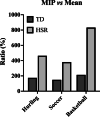The Maximal Intensity Period: Rationalising its Use in Team Sports Practice
- PMID: 36224479
- PMCID: PMC9556679
- DOI: 10.1186/s40798-022-00519-7
The Maximal Intensity Period: Rationalising its Use in Team Sports Practice
Abstract
Quantifying the highest intensity of competition (the maximal intensity period [MIP]) for varying durations in team sports has been used to identify training targets to inform the preparation of players. However, its usefulness has recently been questioned since it may still underestimate the training intensity required to produce specific physiological adaptations. Within this conceptual review, we aimed to: (i) describe the methods used to determine the MIP; (ii) compare the data obtained using MIP or whole-match analysis, considering the influence of different contextual factors; (iii) rationalise the use of the MIP in team sports practice and (iv) provide limitations and future directions in the area. Different methods are used to determine the MIP, with MIP values far greater than those derived from averaging across the whole match, although they could be affected by contextual factors that should be considered in practice. Additionally, while the MIP might be utilised during sport-specific drills, it is inappropriate to inform the intensity of interval-based, repeated sprint and linear speed training modes. Lastly, MIP does not consider any variable of internal load, a major limitation when informing training practice. In conclusion, practitioners should be aware of the potential use or misuse of the MIP.
Keywords: Football; Global positioning system; Performance; Rolling average; Small-sided games; Soccer; Team sports; Time–motion analysis; Training.
© 2022. The Author(s).
Conflict of interest statement
Dan Weaving, Damien Young, Andrea Riboli, Ben Jones and Giuseppe Coratella declare no conflicts of interest.
Figures


Similar articles
-
Time-motion analysis of small-sided training games and competition in elite women soccer players.J Strength Cond Res. 2008 Mar;22(2):543-52. doi: 10.1519/JSC.0b013e3181635597. J Strength Cond Res. 2008. PMID: 18550972
-
An Evaluation of Training Load Measures for Drills in Women's Collegiate Lacrosse.Int J Sports Physiol Perform. 2021 Jun 1;16(6):841-848. doi: 10.1123/ijspp.2020-0029. Epub 2021 Feb 24. Int J Sports Physiol Perform. 2021. PMID: 33626504
-
The Relationships Between Internal and External Measures of Training Load and Intensity in Team Sports: A Meta-Analysis.Sports Med. 2018 Mar;48(3):641-658. doi: 10.1007/s40279-017-0830-z. Sports Med. 2018. PMID: 29288436 Review.
-
Relationship between tests of physical qualities and physical match performance in elite rugby league players.J Strength Cond Res. 2013 Jun;27(6):1539-45. doi: 10.1519/JSC.0b013e318274f236. J Strength Cond Res. 2013. PMID: 23037614
-
When Is a Sprint a Sprint? A Review of the Analysis of Team-Sport Athlete Activity Profile.Front Physiol. 2017 Jun 20;8:432. doi: 10.3389/fphys.2017.00432. eCollection 2017. Front Physiol. 2017. PMID: 28676767 Free PMC article. Review.
Cited by
-
Characterizing the most demanding passages of kinematic and mechanical activity in elite football: a multifactorial approach.Biol Sport. 2024 Oct;41(4):41-50. doi: 10.5114/biolsport.2024.134756. Epub 2024 Mar 17. Biol Sport. 2024. PMID: 39416514 Free PMC article.
-
The data analysis of sports training by ID3 decision tree algorithm and deep learning.Sci Rep. 2025 Apr 29;15(1):15060. doi: 10.1038/s41598-025-99996-5. Sci Rep. 2025. PMID: 40301591 Free PMC article.
-
Top-class women's soccer performance: peak demands and distribution of the match activities relative to maximal intensities during official matches.Biol Sport. 2024 Jan;41(1):207-215. doi: 10.5114/biolsport.2024.129477. Epub 2023 Aug 8. Biol Sport. 2024. PMID: 38188116 Free PMC article.
-
Machine Learning on Prediction of Relative Physical Activity Intensity Using Medical Radar Sensor and 3D Accelerometer.Sensors (Basel). 2023 Mar 30;23(7):3595. doi: 10.3390/s23073595. Sensors (Basel). 2023. PMID: 37050655 Free PMC article.
-
Characterization of Running Intensity in Canadian Football Based on Tactical Position.Sensors (Basel). 2024 Apr 21;24(8):2644. doi: 10.3390/s24082644. Sensors (Basel). 2024. PMID: 38676261 Free PMC article.
References
-
- Cunningham DJ, Shearer DA, Carter N, Drawer S, Pollard B, Bennett M, et al. Assessing worst case scenarios in movement demands derived from global positioning systems during international rugby union matches: rolling averages versus fixed length epochs. PLoS ONE. 2018;13:1–14. doi: 10.1371/journal.pone.0195197. - DOI - PMC - PubMed
-
- Wass J, Mernagh D, Pollard B, Stewart P, Fox W, Parmar N, et al. A comparison of match demands using ball-in-play vs. whole match data in elite male youth soccer players. Sci Med Football. 2020;4:142–147. doi: 10.1080/24733938.2019.1682183. - DOI

